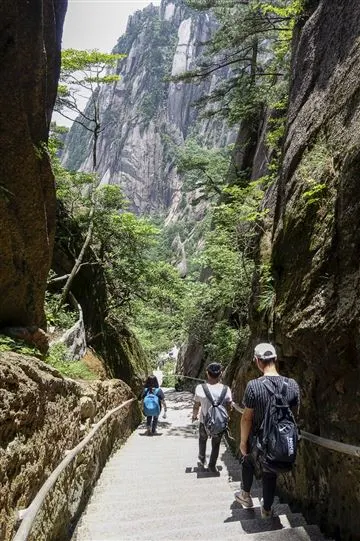HUANGSHAN, China — On one of the world’s most beautiful mountains stands one of China’s most famous trees.
 |
| The Greeting Pine is thought to be more than 1,000 years old. |
A specimen of rugged, flat-crowned evergreen that may be 1,000 years old, the Greeting Pine — or Yingkesong in Mandarin — overlooks a dramatic landscape of granite peaks and mist-shrouded valleys of Huangshan.
The tree is so well-known, it even has a bodyguard — Hu Xiaochun, the 19th Guardian of the Pine.
“My main job is to protect and monitor the Greeting Pine everyday,” Hu told NBC News.
When he's on duty, every two hours, every day of the year, Hu has to inspect the tree and log details about its condition and the local environment. He also guards the tree from squirrels and monkeys that could damage its branches, and he’s there to support it through snowstorms and typhoons.
 |
| Hu Xiaochun checks a branch of the Greeting Pine, overlooking a dramatic backdrop of granite mountains in China's Huangshan are |
Tourists love the Greeting Pine. They love it so much, they may be loving it to death.
“Human sweat damages the bark, and we are trying to ensure that it keeps growing naturally," Hu said.
 |
| Huangshan Mountain is in Anhui Province in eastern China |
Although Hu is supported by a team of 20 — including specialized arborists — the primary responsibility for the tree’s health falls on his shoulders.
As income levels rise, ever-increasing numbers of Chinese are starting to travel domestically. Tens of millions of tourists now flock to China’s national parks every year.
More than 3.3 million people traveled to Huangshan in Anhui Province in 2016, according to the local tourism bureau. And almost all of these visitors invariably pause for a portrait or a selfie in front of the Greeting Pine.
Dr. Zhan Dongmei, a specialist in scenic areas at the China Tourism Academy, said the "concepts of environmental protection and sustainable eco-tourism" did not exist when the tourism industry was established four decades ago.
Air pollution in major cities like Beijing may be the more visible indications of China’s struggle to contain the damage wrought by its rapid industrialization, but scenic areas like Huangshan are increasingly on the front lines in the battle to protect the country’s natural beauty and environment.
“Famous scenic sites often have millennia of history as sacred sites,” said Dr. Judith Shapiro, a researcher at American University and the author of "China’s Environmental Challenges."
 |
| Extensive visitor facilities have been constructed on Huangshan to support the millions of tourists that visit one of China’s most iconic natural parks each year. |
“These places have always been desirable destinations for their landscapes and spiritual values," she said. "What has changed is that the Chinese now have disposable income to allow them to travel for pleasure, and these sites are becoming inundated with commercial enterprises and the tourists who use them. As a result some sites are being ‘loved to death.’”
China’s government is increasingly focused on environmental issues.
In October, President Xi Jinping gave an annual speech to the National People’s Congress — roughly analogous to America's State of the Union address. Over three hours, Xi mentioned the environment or related terms 89 times, according to an analysis by Bloomberg Intelligence, while mentioning the economy only 70 times.
China must “ensure that the ecology and environment are fundamentally improved by 2035, and that our goal of building a beautiful China is basically achieved,” Xi told the People’s Congress.












0 Comments:
Post a Comment